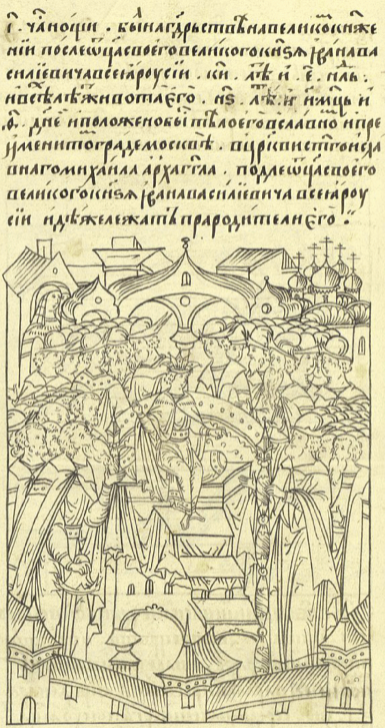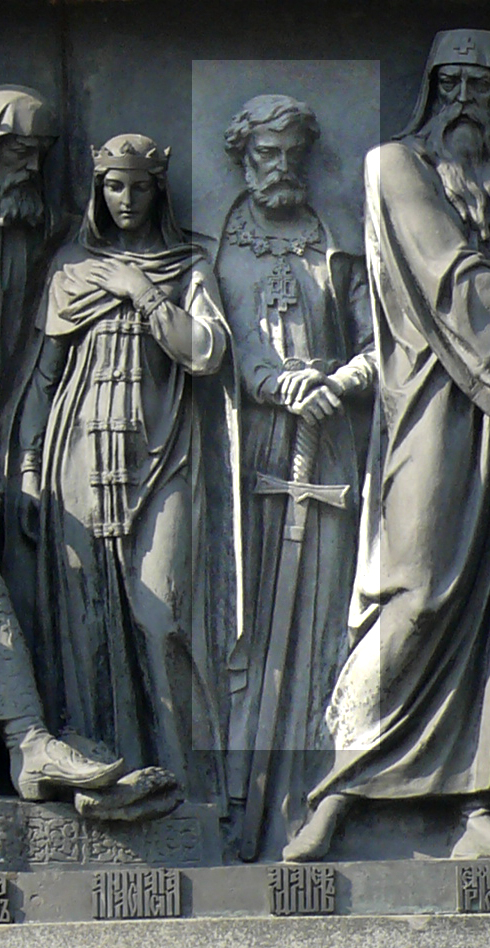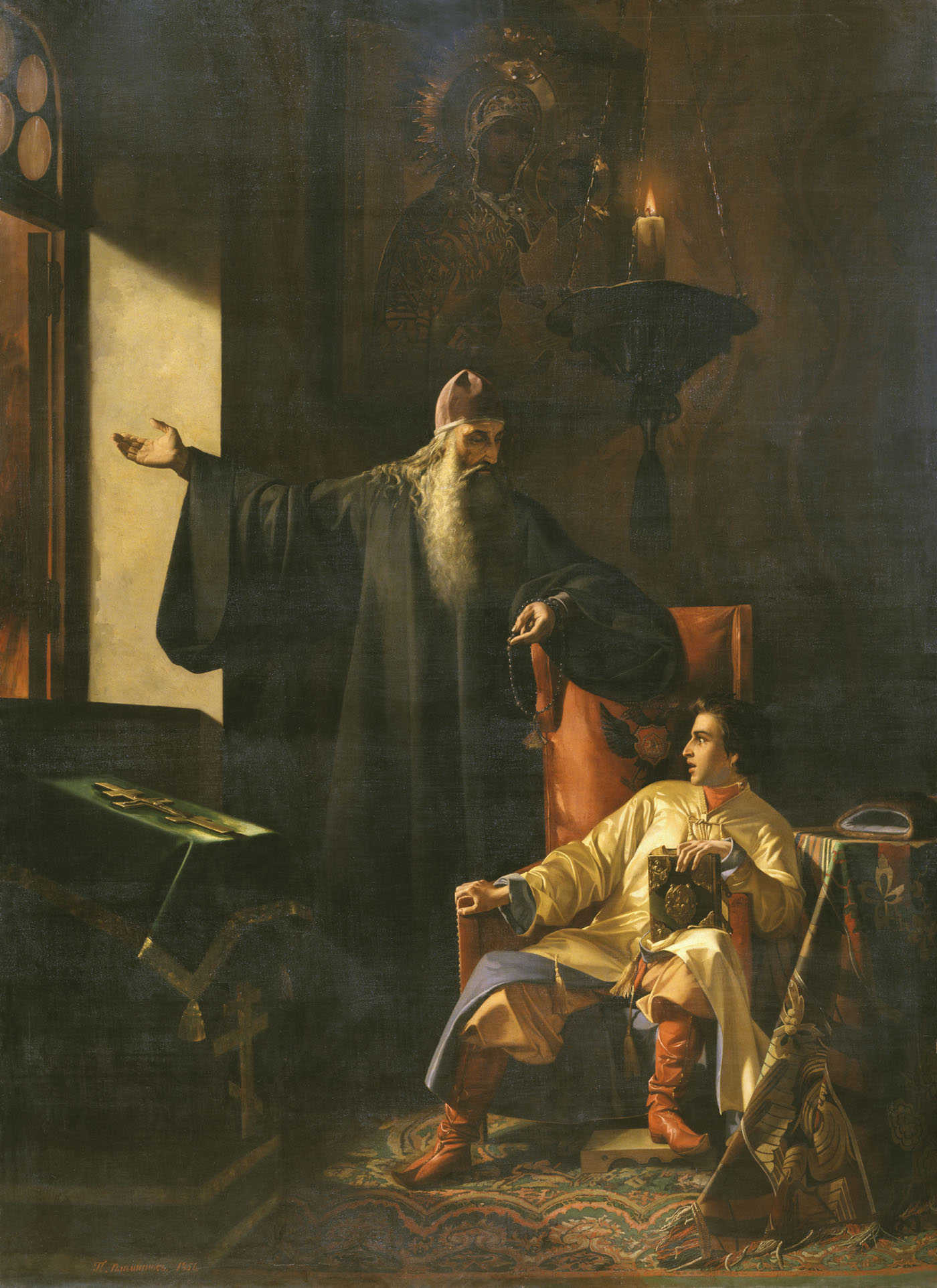|
Chosen Council
The Chosen Council () is the informal name given to the government of Ivan the Terrible during the early years of his reign as the tsar of Russia, from about 1547 to 1560. History According to the traditional view, the council was formed in 1547 after the fire of Moscow. Ivan placed Aleksey Adashev in charge of the council while the priest Sylvester and other advisors served on the council. Ivan ruled the country with these advisors. After the death of Ivan's wife Anastasia in 1560, Ivan lost faith in the council. Although historians disagree on the exact status of the council, it is generally considered that this council formed the government and it may have been an attempt at balancing the tsar's powers with those of the higher aristocracy. The Chosen Council became an instrument of reform. The governors of provinces were required to share the presiding chair at provincial courts with the '' pomeshchiki'', the service nobility. By 1555, many of the governors had been dismissed a ... [...More Info...] [...Related Items...] OR: [Wikipedia] [Google] [Baidu] |
Ivan The Terrible
Ivan IV Vasilyevich (; – ), commonly known as Ivan the Terrible,; ; monastic name: Jonah. was Grand Prince of Moscow, Grand Prince of Moscow and all Russia from 1533 to 1547, and the first Tsar of all Russia, Tsar and Grand Prince of all Russia from 1547 until his death in 1584. Ivan's reign was characterised by Russia's transformation from a medieval state to a fledgling empire, but at an immense cost to its people and long-term economy. Ivan IV was the eldest son of Vasili III of Russia, Vasili III by his second wife Elena Glinskaya, and a grandson of Ivan III of Russia, Ivan III. He succeeded his father after his death, when he was three years old. A group of reformers united around the young Ivan, crowning him as tsar in 1547 at the age of 16. In the early years of his reign, Ivan ruled with the group of reformers known as the Chosen Council and established the ''Zemsky Sobor'', a new assembly convened by the tsar. He also revised the Sudebnik of 1550, legal code and in ... [...More Info...] [...Related Items...] OR: [Wikipedia] [Google] [Baidu] |
Tsar
Tsar (; also spelled ''czar'', ''tzar'', or ''csar''; ; ; sr-Cyrl-Latn, цар, car) is a title historically used by Slavic monarchs. The term is derived from the Latin word '' caesar'', which was intended to mean ''emperor'' in the European medieval sense of the term—a ruler with the same rank as a Roman emperor, holding it by the approval of another emperor or a supreme ecclesiastical official—but was usually considered by Western Europeans to be equivalent to "king". Tsar and its variants were the official titles in the First Bulgarian Empire (681–1018), Second Bulgarian Empire (1185–1396), the Kingdom of Bulgaria (1908–1946), the Serbian Empire (1346–1371), and the Tsardom of Russia (1547–1721). The first ruler to adopt the title ''tsar'' was Simeon I of Bulgaria. Simeon II, the last tsar of Bulgaria, is the last person to have held this title. Meaning in Slavic languages The title tsar is derived from the Latin title for the Roman emperors, ''c ... [...More Info...] [...Related Items...] OR: [Wikipedia] [Google] [Baidu] |
Fire Of Moscow (1547)
The great fire of Moscow in 1547 destroyed sections of Moscow that had been built almost entirely of wood. The fire swept into the Kremlin and blew up the powder stores in several of the Kremlin's towers. The fire began on 24 June, several months after Ivan IV, better known as "Ivan the Terrible," was officially crowned as first tsar of all Russia. The fire displaced about 80,000 people and killed about 2,700 to 3,700 people (not including children), and led to widespread poverty among the survivors. Metropolitan Macarius was apparently injured in the fire when the Cathedral of the Dormition in the Kremlin was threatened by the flames and the metropolitan was taken out through a breach in the Kremlin walls and let down by rope into the Moscow River. He may have never fully recovered from his injuries, although he lived another 16 years. The Muscovites put the blame on the tsar's maternal relatives from the . A rebellion began and Yuri Glinski was stoned to death inside the C ... [...More Info...] [...Related Items...] OR: [Wikipedia] [Google] [Baidu] |
Aleksey Adashev
Aleksey Fyodorovich Adashev (, died 1561) was a Russian statesman, okolnichy, , voivode of Livonia. He was a confidant of Tsar Ivan the Terrible, but fell out of favor and was imprisoned in Yuryev (now Tartu) in 1560, where he died.''Great Soviet Encyclopedia The ''Great Soviet Encyclopedia'' (GSE; , ''BSE'') is one of the largest Russian-language encyclopedias, published in the Soviet Union from 1926 to 1990. After 2002, the encyclopedia's data was partially included into the later ''Great Russian Enc ...'', article "Адашев, Алексей Фёдорович"(en) References Year of birth missing 1561 deaths 16th-century Russian people {{russia-bio-stub ... [...More Info...] [...Related Items...] OR: [Wikipedia] [Google] [Baidu] |
Sylvester (priest)
Sylvester (; later known as Spiridon) was a priest of the Cathedral of the Annunciation, Moscow, Cathedral of the Annunciation and a close advisor to Ivan the Terrible, Ivan IV. Sylvester is known for heavily influencing Ivan and the contemporary Russian government alongside Aleksey Adashev, Alexei Adashev and their Chosen Council from 1549 to 1560. His power was mostly unchallenged during this time, with the exception of the Viskovatyi affair, but that was quickly solved in his favor. He eventually fell out of favor with the Tsar in 1560 and withdrew to the Kirillo-Belozersky Monastery, Kirillov monastery in Belozersk, Beloozero before moving to the Solovetsky Monastery, Solovetskii monastery, at some point changing his name to Spiridon and later dying before 1580. He is later described by Ivan as a traitor and conspirator. Early life The details of Sylvester's early life are largely unknown, as most biographical information on him is from inscriptions in books he donated t ... [...More Info...] [...Related Items...] OR: [Wikipedia] [Google] [Baidu] |
Anastasia Romanovna
Anastasia Romanovna Zakharyina-Yurieva (; 1530 – 7 August 1560) was the tsaritsa of all Russia as the first wife of Ivan IV of Russia, Ivan IV, the tsar of all Russia. She was also the mother of Feodor I of Russia, Feodor I, the last lineal Rurikid tsar of Russia, and the great-aunt of Michael of Russia, the first tsar of the Romanov dynasty. Early life and ancestry Anastasia was the daughter of the boyar Roman Yurievich Zakharyin-Koshkin, who served as Okolnichy during the reign of Grand Prince Vasily III. The House of Zakharyin-Yuriev was a minor branch of a Russian nobility, Russian noble family that had already been at court. Ivan had met Anastasia before the Bride-show, bride show as her uncle had been one of Ivan's guardians. Anastasia's father was descended from the boyar Feodor Koshka, Feodor "Koshka" ("Cat") Kobyla, fourth son of Andrei Kobyla. Her mother was Juliana Fedorovna Karpova, daughter of Russian Boyar, publicist and diplomat Fedor Ivanovich Karpov (d. 154 ... [...More Info...] [...Related Items...] OR: [Wikipedia] [Google] [Baidu] |
Pomeshchik
In the history of Russia pomeshchiks () were the class of Russian nobility who owned a ''pomestye'' (), i.e., an estate. The term ''pomeshchik'' is commonly translated in English as "landlord". History It terms of land ownership there used to be two major categories of land ownership. In , a sovereign (tsar or ''knyaz'') could grant a piece of state-owned land to a person for his service (usually military) into personal ownership, for the term of the service or for life. Its temporary and conditional character constituted the differencer from the '' votchina'' system, whereby land ownership was hereditary. Over time the two systems blended into one under the term ''pomestye ownership''. This was finalized by Peter the Great in his 1714 , whose main rule of law was inheritance of the real estate regardless its type by a single son, hence the name. The "single inheritance" clause was amended in 1730 by Empress Anna of Russia Anna Ioannovna (; ), also russified as Anna Ivanovna a ... [...More Info...] [...Related Items...] OR: [Wikipedia] [Google] [Baidu] |
Vladimir Of Staritsa
Vladimir Andreyevich (; 9 July 1535 – 9 October 1569) was the last appanage Russian prince. His complicated relationship with his cousin, Ivan the Terrible, was dramatized in Sergei Eisenstein's 1945 film ''Ivan the Terrible (1945 film), Ivan the Terrible''. Life The only son of Andrey of Staritsa and his wife Yefrosinya Staritskaya (), Vladimir spent his childhood under strict surveillance in Moscow. In 1541, he was released along with his mother: "the grand prince Ivan Vasilyevich of all Russia granted at the intercession of his father Joasaphus, the metropolitan of all Russia, and his boyars, the prince Vladimir Andreyevich and his mother, the princess Yefrosinya, the wife of the prince Andrey Ivanovich, to be released from detention, and the prince Vladimir was ordered to be at his father's court, the prince Andrey Ivanovich, and with his mother". He was reinstated in his father's appanages, Staritsa (town), Tver Oblast, Staritsa and Vereya, Naro-Fominsky District, M ... [...More Info...] [...Related Items...] OR: [Wikipedia] [Google] [Baidu] |
Andrey Kurbsky
Prince Andrey Mikhailovich Kurbsky (1528?–1583) was a Russian political figure, military leader, and political philosopher, known as an intimate friend and then a leading political opponent of the Russian tsar Ivan the Terrible (). He defected to the Grand Duchy of Lithuania around 1564, in the midst of the Livonian War. Kurbsky purported correspondence with tsar Ivan provides a unique source for the history of 16th-century Russia, although the attribution to Kurbsky of these letters and other works has been debated in scholarly circles since 1971. Life Andrey Kurbsky was born in the village of Kurba near Yaroslavl. In a legal document from 9 October 1571, he spelt his own name in Latin letters as ''Andrej Kurpski manu proprija'', while declaring "I am unable to write in Cyrillic." Given that all texts that have been preserved in his name or have been attributed to him have been written in Cyrillic, this has posed problems for proponents of authenticity. On the other hand, th ... [...More Info...] [...Related Items...] OR: [Wikipedia] [Google] [Baidu] |
Illustrated Chronicle Of Ivan The Terrible
The Illustrated Chronicle of Ivan the Terrible (; 1560-1570s) is the largest compilation of historical information ever assembled in medieval Russia. It is also informally known as the Tsar Book (Царь-книга), in an analogy with the Tsar Bell and Tsar Cannon. (retrieved May 10, 2015) The set of manuscripts was commissioned by tsar Ivan the Terrible and was made by group of anonymous manuscript illuminators in the Tsar's palace in Alexandrov, Vladimir Oblast, Alexandrovskaya Sloboda and Mo ... [...More Info...] [...Related Items...] OR: [Wikipedia] [Google] [Baidu] |
Ruslan Skrynnikov
Ruslan Grigorievich Skrynnikov (Руслан Григорьевич Скрынников; 8 January 1931, Kutaisi, Georgian SSR – 16 June 2009, St. Petersburg, Russia) was a Russian historian who studied the reign of Ivan the Terrible. He later moved on to study the Time of Troubles. For Skrynnikov, control over the bureaucratic apparatus (rather than the issue of centralization) was the primary point of contention explaining Muscovite political struggles of the 15th and 16th centuries. Nancy Shields Kollmann. ''Kinship and Politics: The Making of the Muscovite Political System, 1345–1547''. Stanford University Press, 1987. Page 15. In the late 1960s he described Ivan's Oprichnina as the reign of terror designed to root out every possible challenge to the autocracy: Skrynnikov' monographs about the Oprichinina and the Russian conquest of Siberia have been reprinted many times and translated into other major languages. He also authored the biographies of Ivan III, Ivan IV ... [...More Info...] [...Related Items...] OR: [Wikipedia] [Google] [Baidu] |
1547 Establishments In Russia
Year 1547 ( MDXLVII) was a common year starting on Saturday of the Julian calendar. Events January–March * January 8 – The first Lithuanian-language book, a ''Catechism'' (, Simple Words of Catechism), is published in Königsberg by Martynas Mažvydas. * January 13 – Henry Howard, Earl of Surrey is sentenced to death for treason in England. * January 16 – Grand Prince Ivan IV is crowned as Tsar of all Russia at the Dormition Cathedral in Moscow, thereby proclaiming the Tsardom of Russia. * January 28 – King Henry VIII of England dies in London, and is succeeded by his 9-year-old son Edward VI, as King of England. * February 20 – Edward VI of England is crowned at Westminster Abbey. * March 31 – King Francis I of France dies at the Château de Rambouillet and is succeeded by his eldest surviving son Henry II (on his 28th birthday) as King of France. April–June * April 4 – Catherine Parr, widow of King Henry VIII of En ... [...More Info...] [...Related Items...] OR: [Wikipedia] [Google] [Baidu] |




